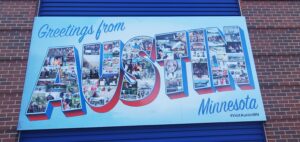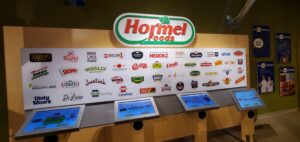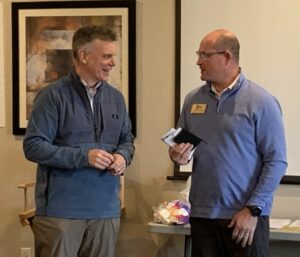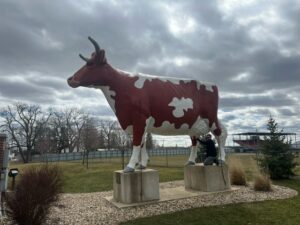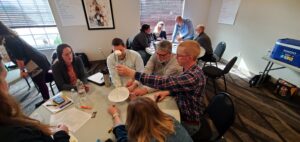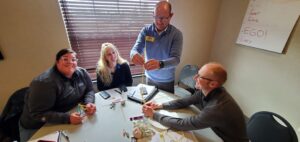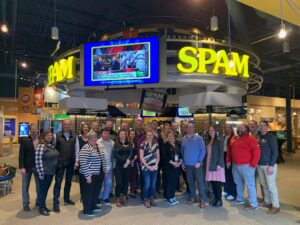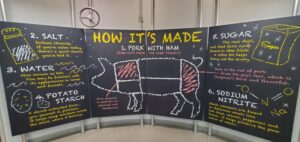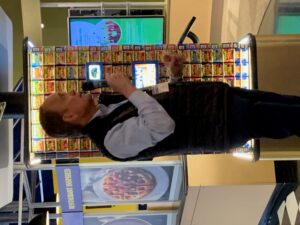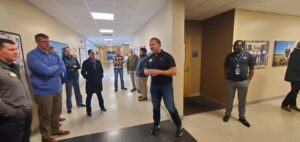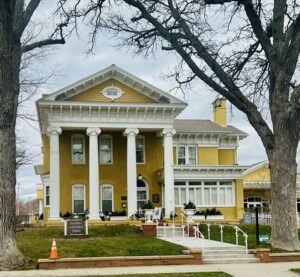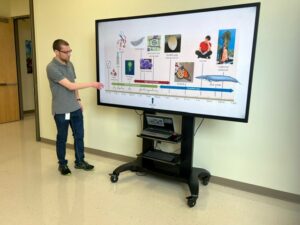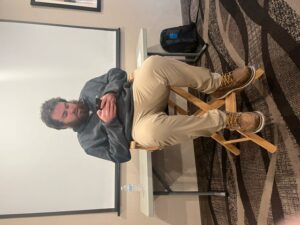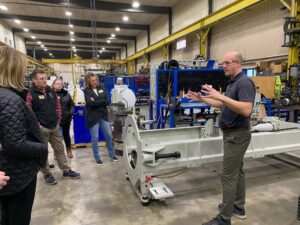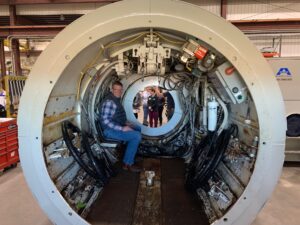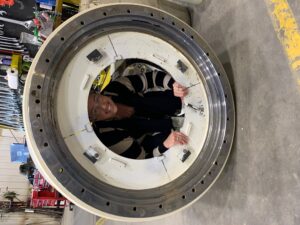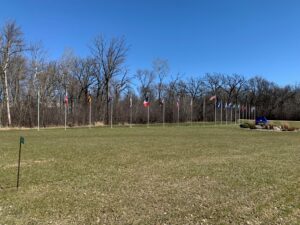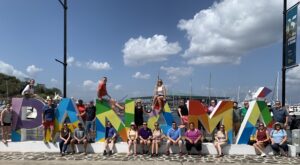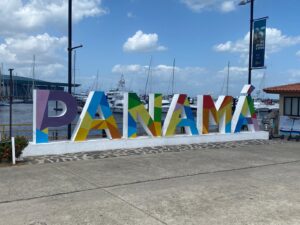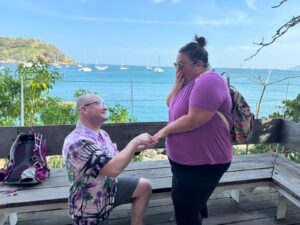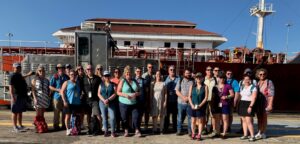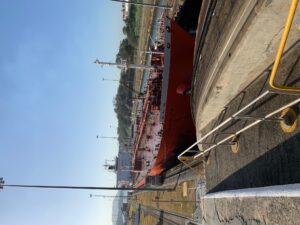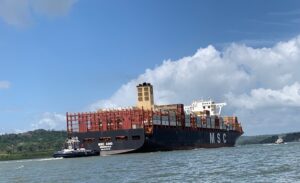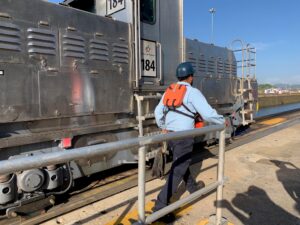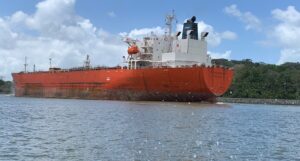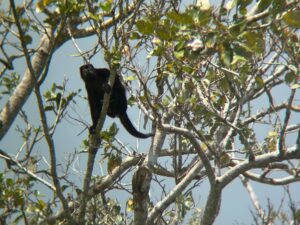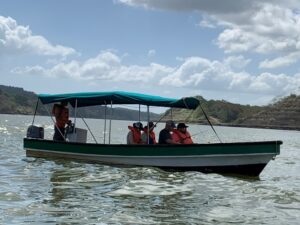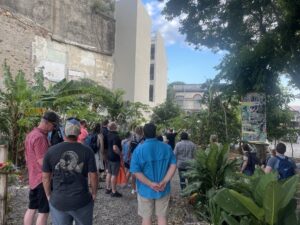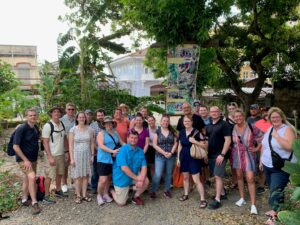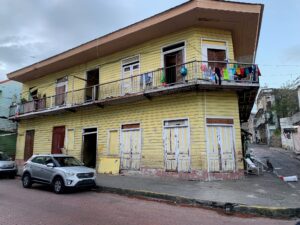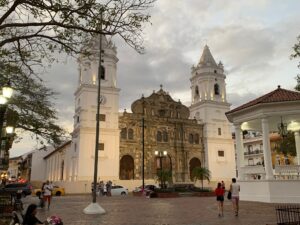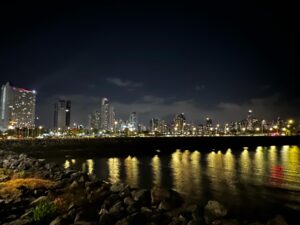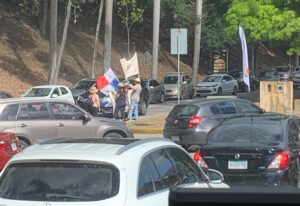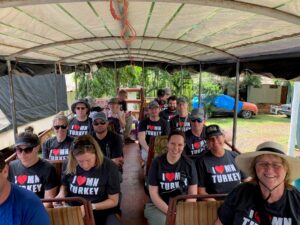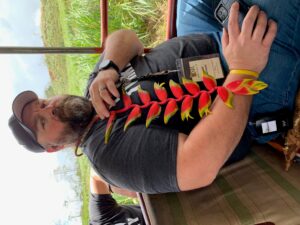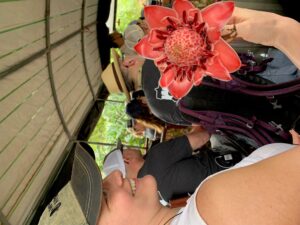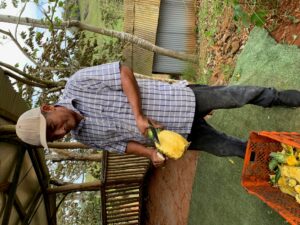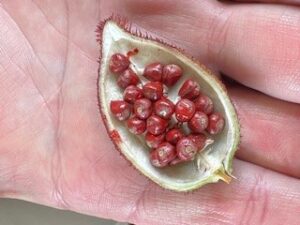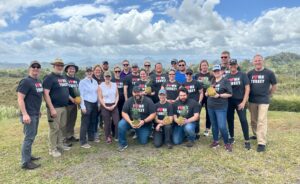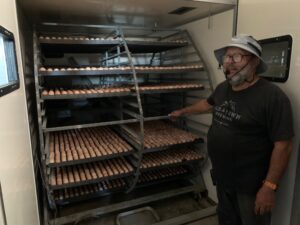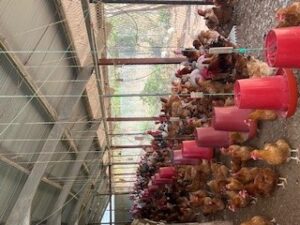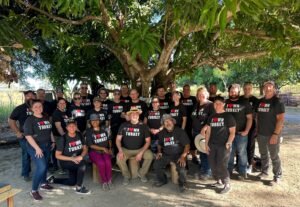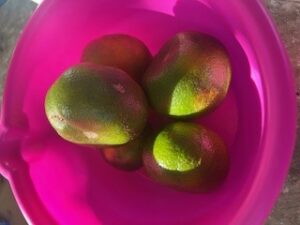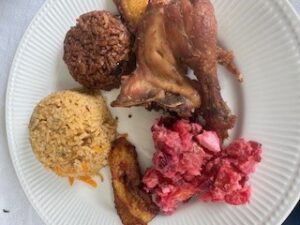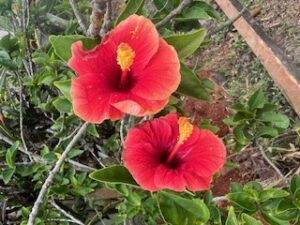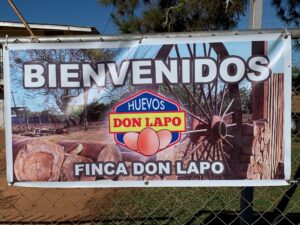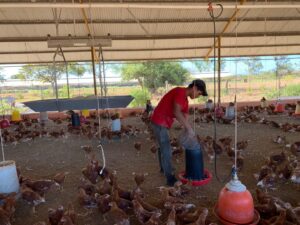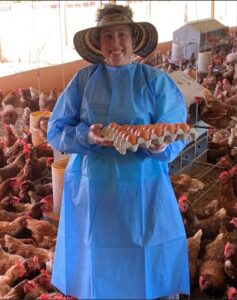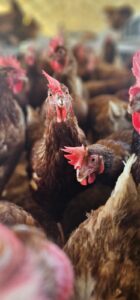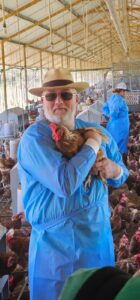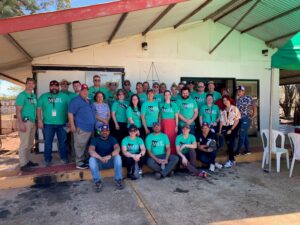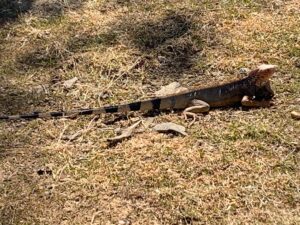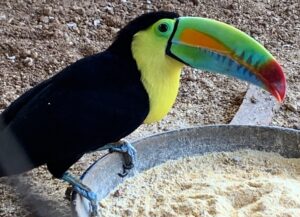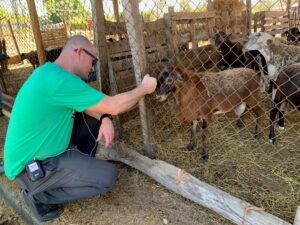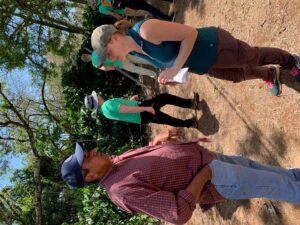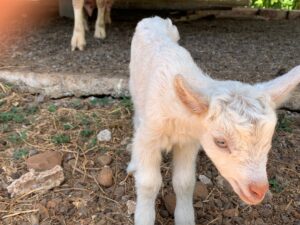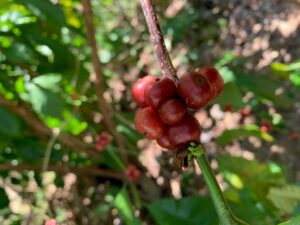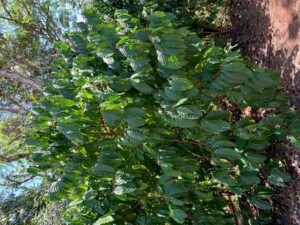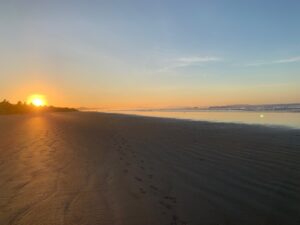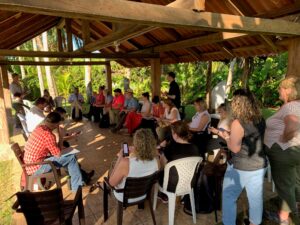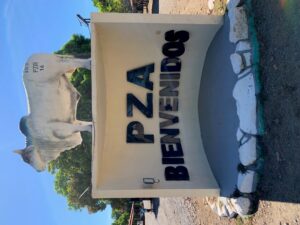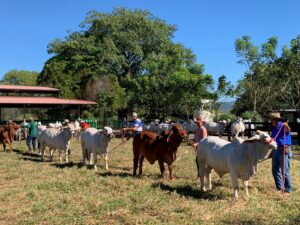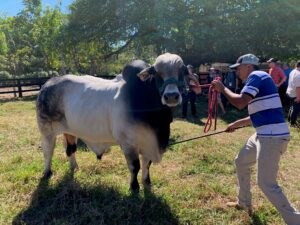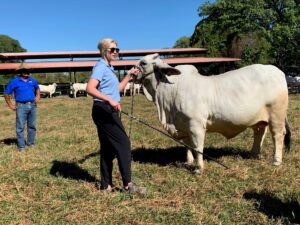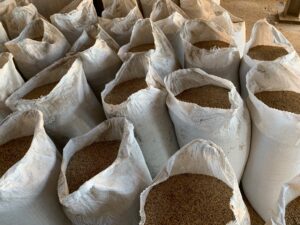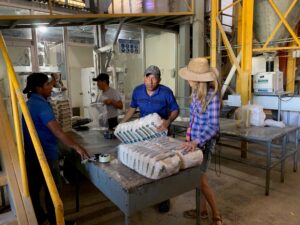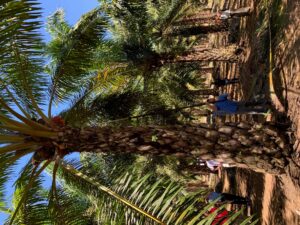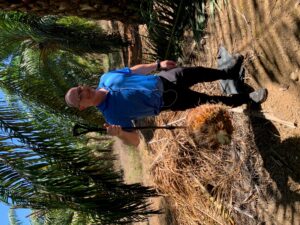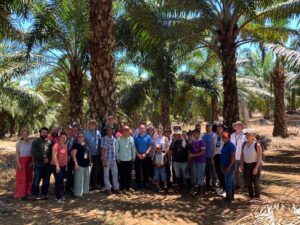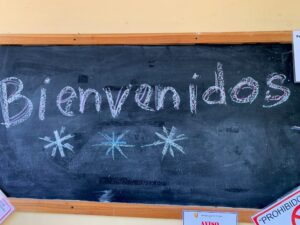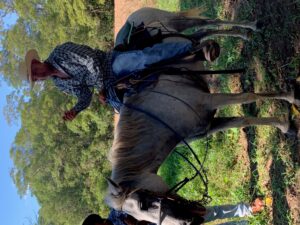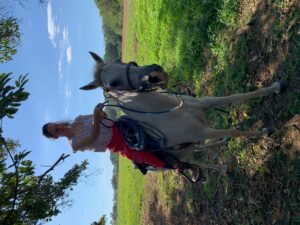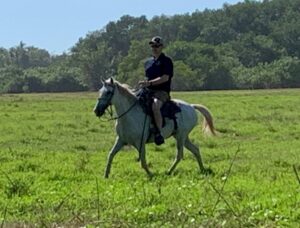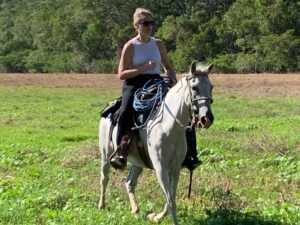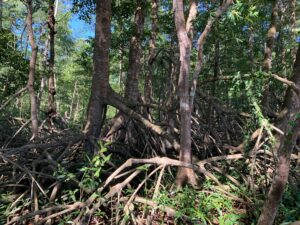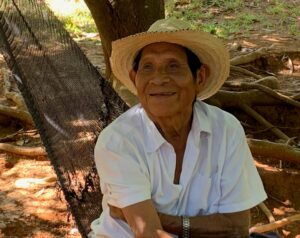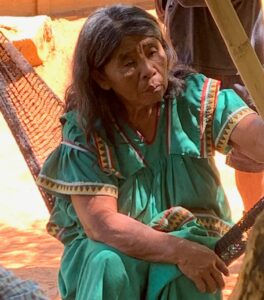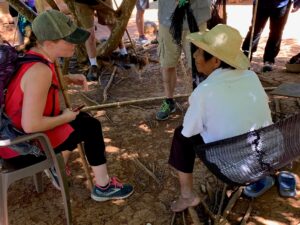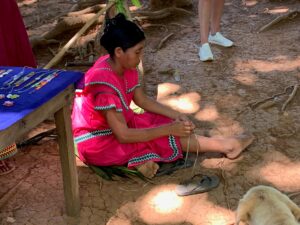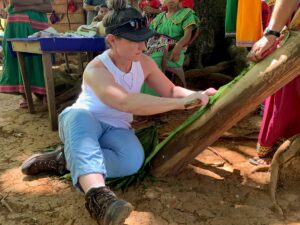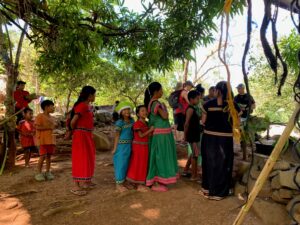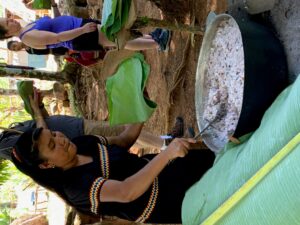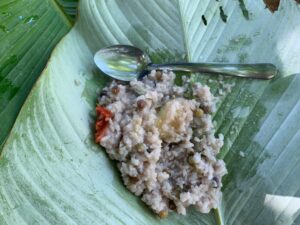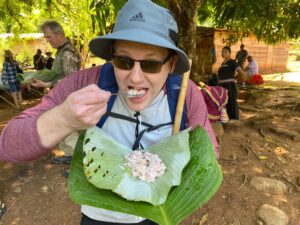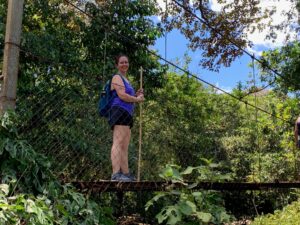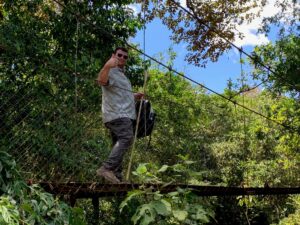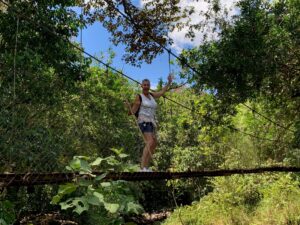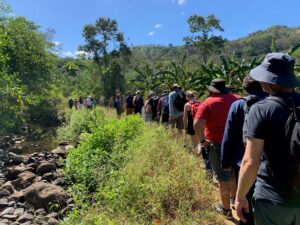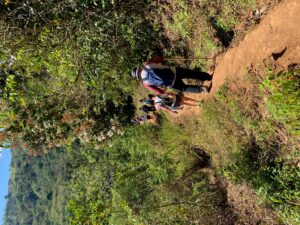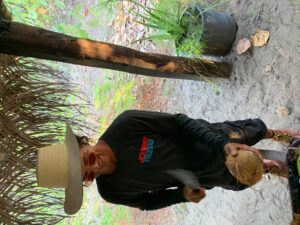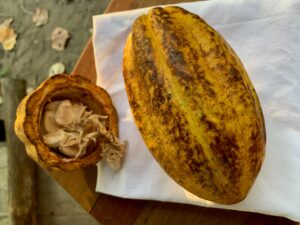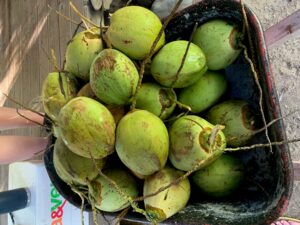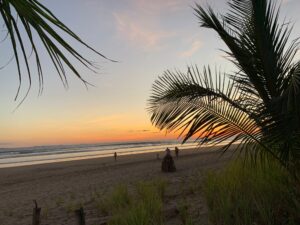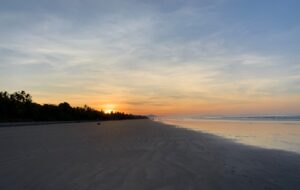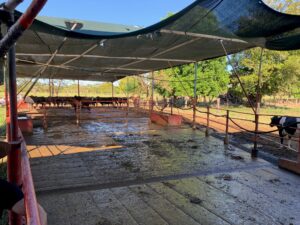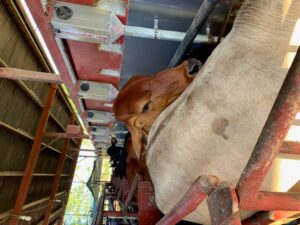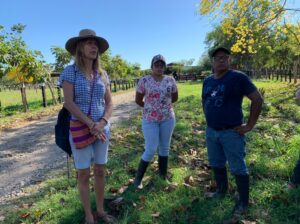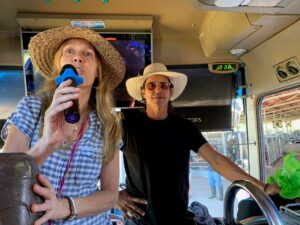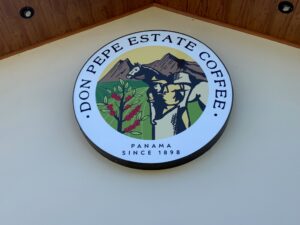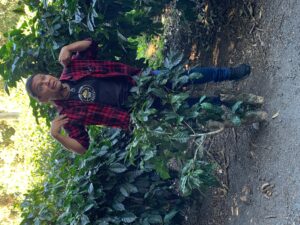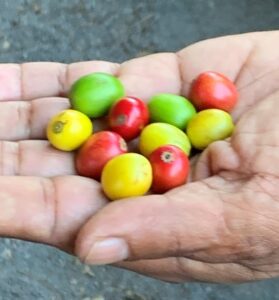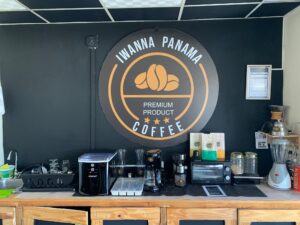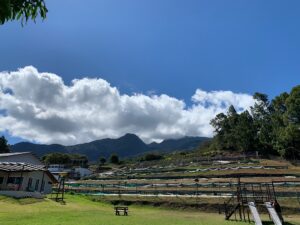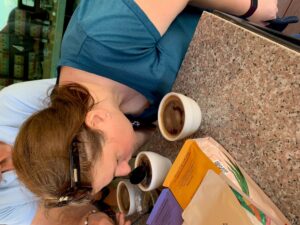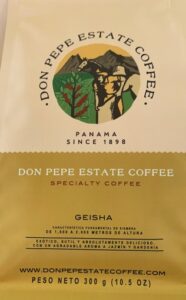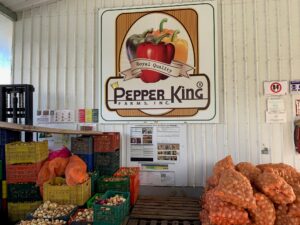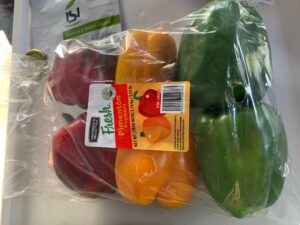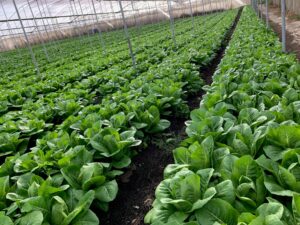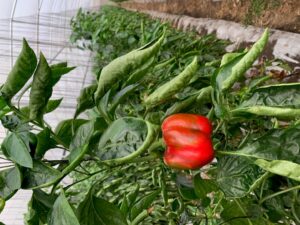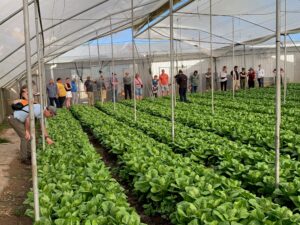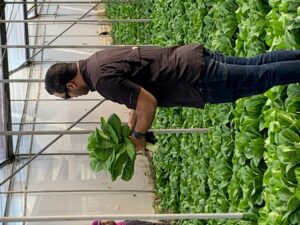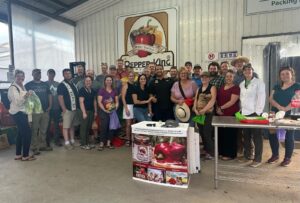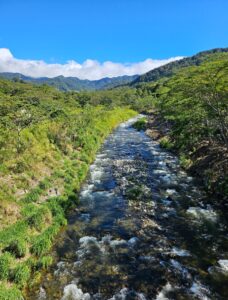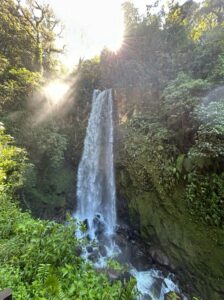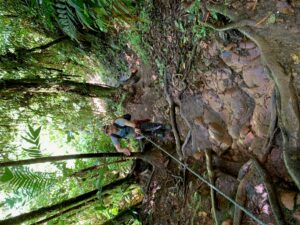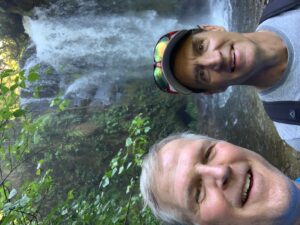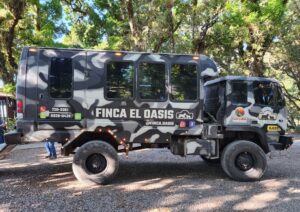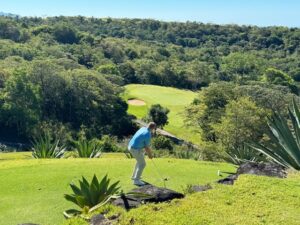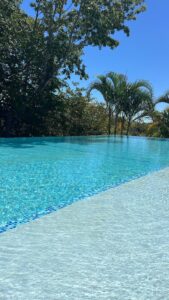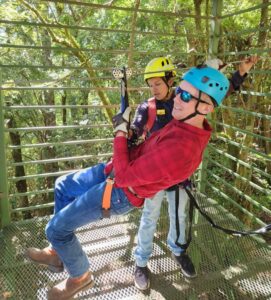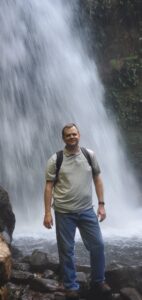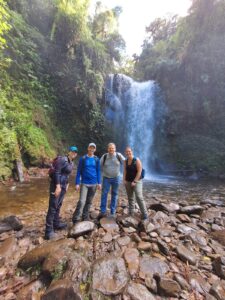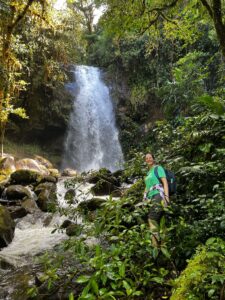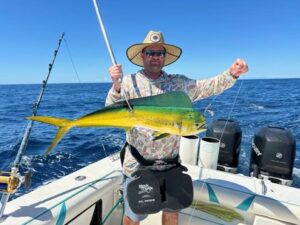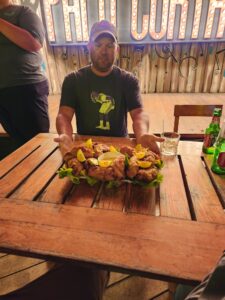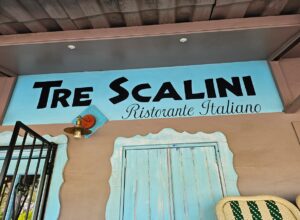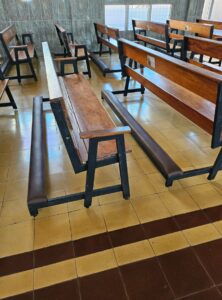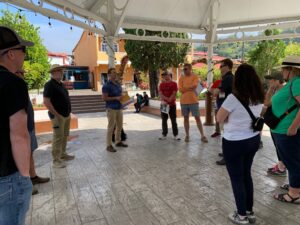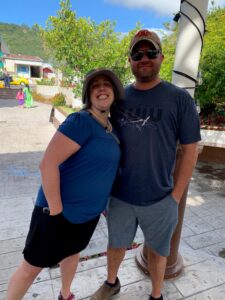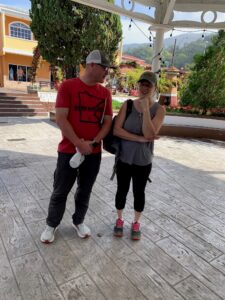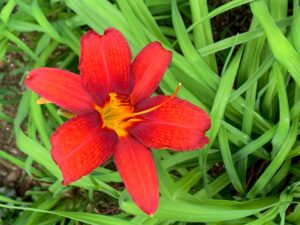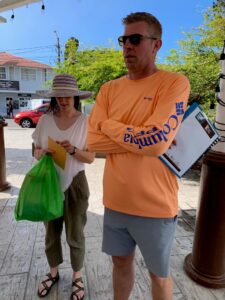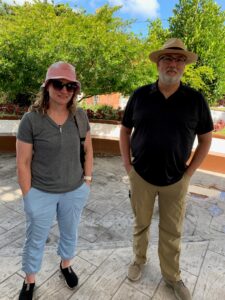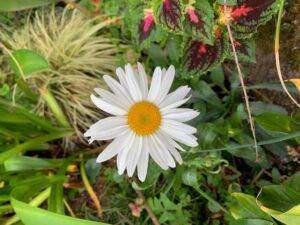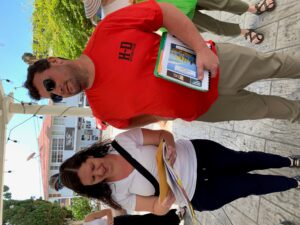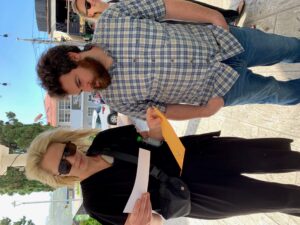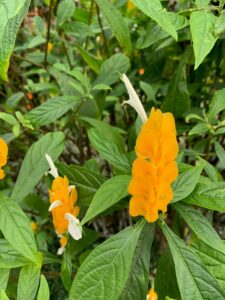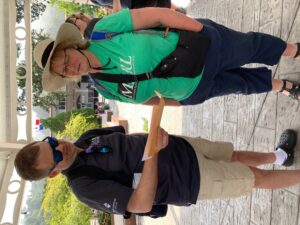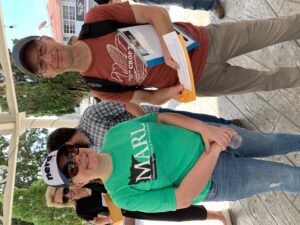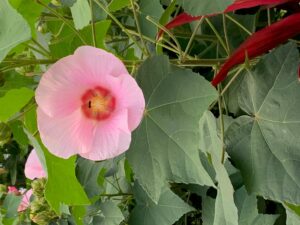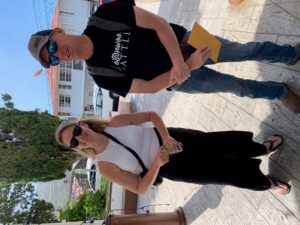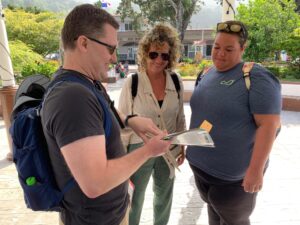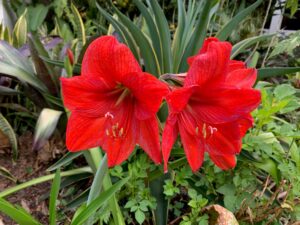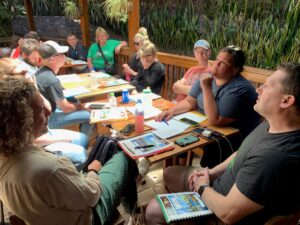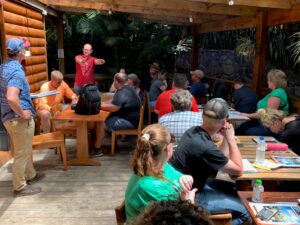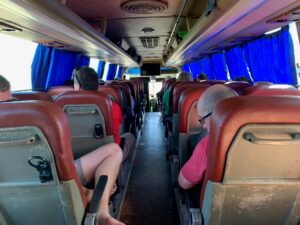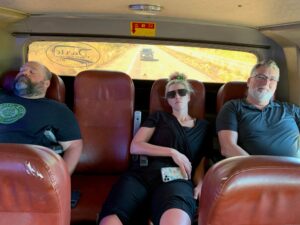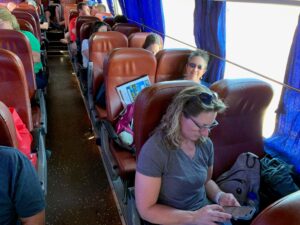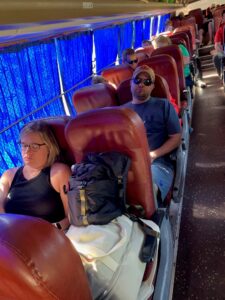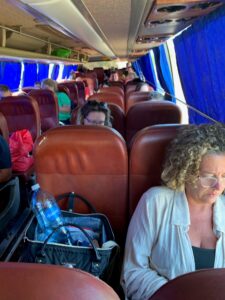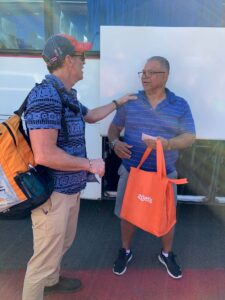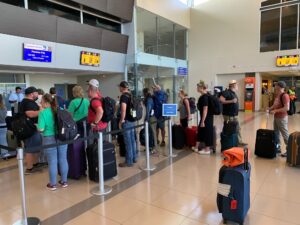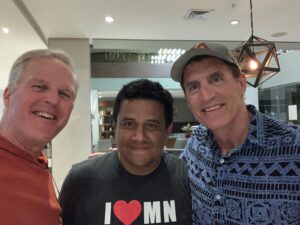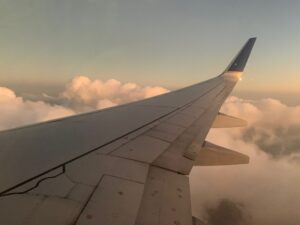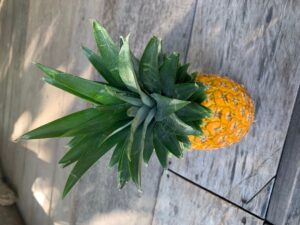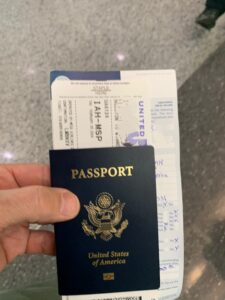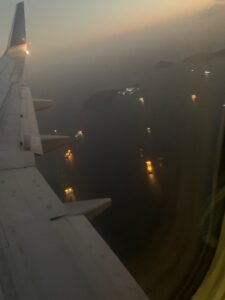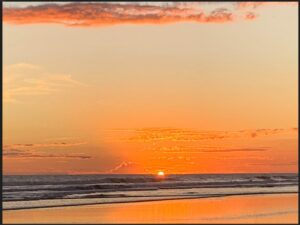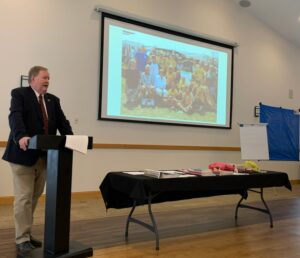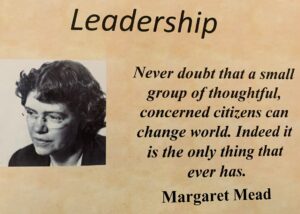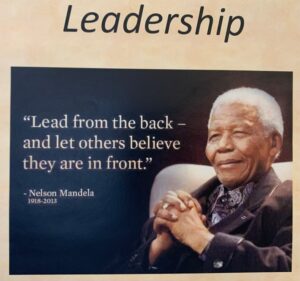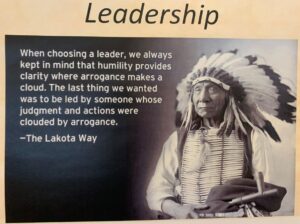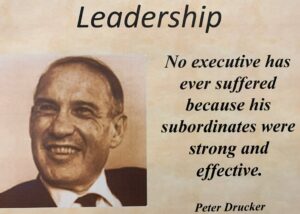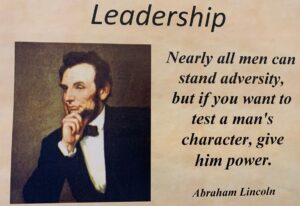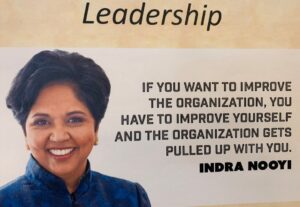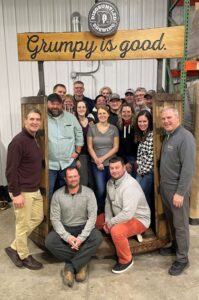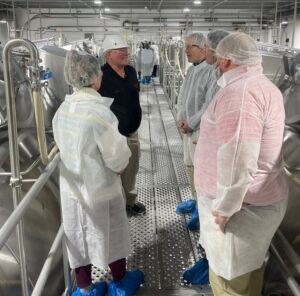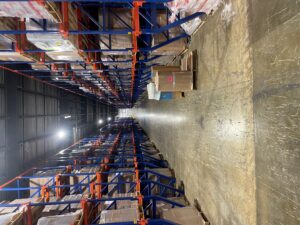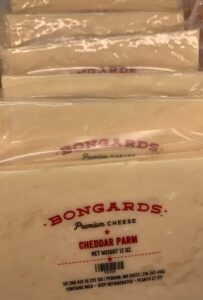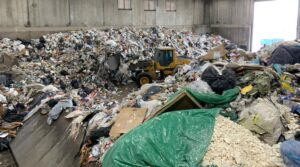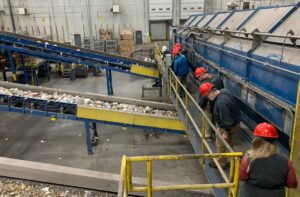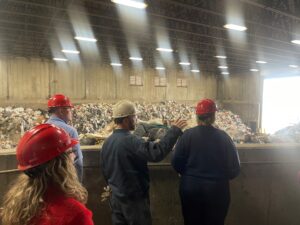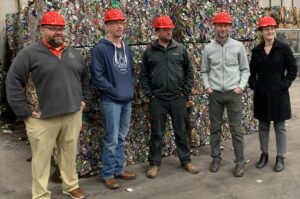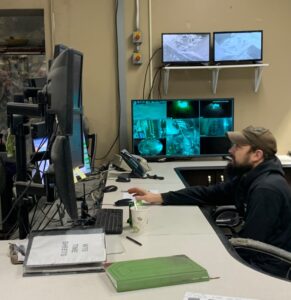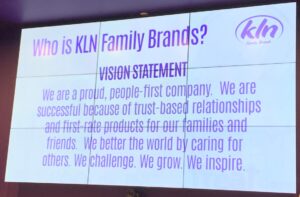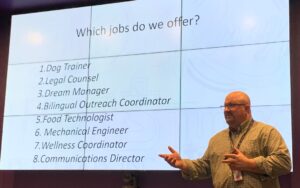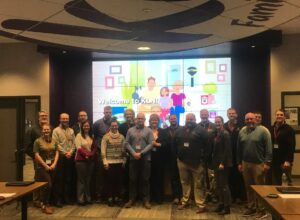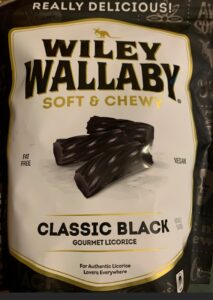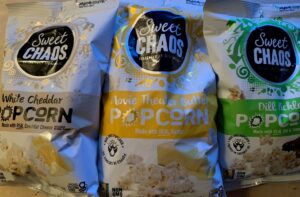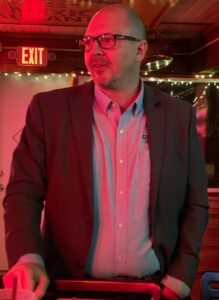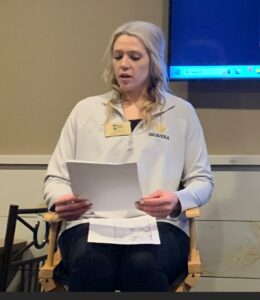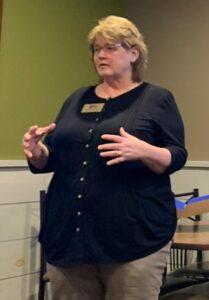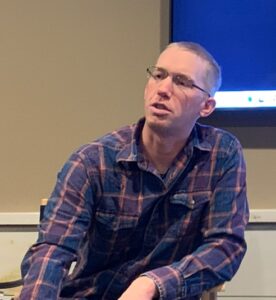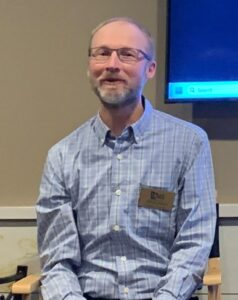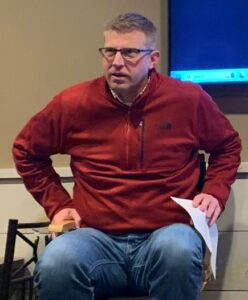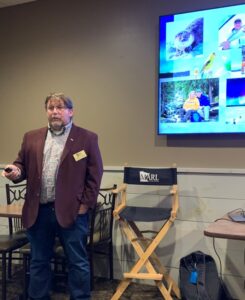The next three days mark our final MARL Seminar before graduation. It’s a little surreal as we’ve bonded and spent valuable time getting to know each other both personally and professionally over the past 20 months. MARL Class XII traveled from various areas throughout the state to gather in southern Minnesota in Austin, also known as SPAM Town USA. Our three days together did not disappoint as we were able to spend time learning what makes Austin such a unique community. The theme for this seminar is “leading innovation and change”.
We began our seminar by spending lunch in the conference room of our hotel hearing from John Garry, who is the President and CEO for Development Corp. of Austin. As part of his role, he works with public and private organizations to help existing businesses grow as well as attract new businesses to the Austin area. Austin has a population of ~26,000 people and employs 12,000 people. John explained that Mower County is a leading county in MN for soy, corn and hogs and agriculture and bio-science are two of its biggest industries. When asked what types of things people do for recreation in Austin, John explained that there is an arts festival and that is a premiere event for Austin. Music is also something big for the area as is mountain biking, but he joked without the mountains or hills.
Austin is home to Hormel Foods, Hormel Institute and the Hormel Foundation, which drive the economy. John stated that the Hormel Foundation, which holds ~48% of Hormel Foods stock, gives back millions of dollars to Austin and other businesses within Mower County. Hormel Institute is a research facility that focuses much of its work on cancer research. Hormel Foods, a Fortune 500 company known for its pork products like bacon and ham, also has other brands like Skippy, Jennie-O, Chi-Chi’s, Planters and many others.
Something that Austin may not be known for, yet, will be a new research center, called The Future of Advanced Agricultural Research in Minnesota (FAARM). This will be a $220M 1,300 acre research facility in northwestern Mower County that is a joint effort between the U of M, Riverland Community College and the Hormel Foundation. FAARM is in the early stages, but the Hormel Foundation has already pledged $60M and this will be a state-of-the-art dairy, poultry, swine and beef facility where industry and education can come together and perform research.
After that introduction to the Austin community, we spent time discussing how change is constant in our lives, but can be unsettling for some. We went through exercises and activities that better help us think about our own reactions to change, which can be detrimental to others while being in a leadership role. We examined the stages of change so that we may take that into consideration as we work with others and consider how people can deal with change. Similar to the adoption lifecycle scale for a new product, the same scale exists for how people adapt to change where some latch onto it right away while others take longer to jump onboard. Thank you Toby for sharing his expertise with us on this topic, including some fun activities like building a spaghetti tower, with some unanticipated changes that were introduced to us amidst the design and building process.
After getting an overview of Austin, we took a short drive to downtown Austin to the SPAM Museum, where we had a private gathering to end our day. We were met by leadership from Hormel Foods as well as MARL Alumni. Jeff Grev, VP of Legislative Affairs of Hormel Foods, did a welcome and we enjoyed visiting with each other and walking through the gift shop and SPAM Museum while learning about its history. Hormel Foods treated us to some wonderful appetizers and beverages and then we were offered a tour of the museum. Here are some fun facts about SPAM: 1. SPAM products are sold in 44 countries around the world. 2. Guam consumes an annual average of 16 cans per person. 3. SPAM is made from six simple ingredients. 4. There are over 10 SPAM varieties. 5. SPAM products were first introduced in 1937. 6. The SPAM JAM Festival is one of Hawaii’s largest festivals every year. 7. Hawaii consumes more SPAM than any other state – more than 8M cans each year.
We had a wonderful first day in Austin and thanks to John, Jeff and others on the Hormel Foods team for the hospitality!
Day 2_ Exploring the Flavors of Austin: A Journey Through Food Innovation
On the first day of our adventure in Austin, Minnesota, we embarked on a journey that left us feeling like wide-eyed kids in a candy store. But instead of candies, we were immersed in the savory world of Spam at the Spam Museum. The tour was nothing short of eye-opening as we delved into the rich history of Spam and its significance, particularly during World War II. Who knew that a humble canned meat product could hold such historical value and global importance?
After our insightful tour at the Spam Museum yesterday, on Day 2 we shifted gears and ventured into the heart of food production at Hormel Foods and QPP Plants. The magnitude of operations at Hormel left us in awe, especially learning about the sheer number of hogs processed to provide us with the pork products we enjoy daily. It was a testament to the impressive scale of Hormel as a company and the dedication of its workforce.
As we explored Riverland Community College, we had the privilege of engaging with Dr. Okechukwu Ukaga and Mr. Nick Schiltz, gaining valuable insights into food and agriculture education. Transitioning to the Hormel Institute, we were treated to a delicious lunch and a thought-provoking discussion on innovation and change.
Our day concluded with an exciting scavenger hunt around Austin, where we explored iconic landmarks and hidden gems, soaking in the vibrant culture of the city. The evening was filled with reflections from the Austin community and captivating presentations on the remaining Shark Tank Capstone Projects.
As we retreated to the hotel, our minds buzzed with newfound knowledge and appreciation for the intricate workings of the food industry. Day 2 was a testament to the remarkable innovation and dedication that fuels Austin’s thriving food community, leaving us inspired and eager for more adventures ahead.
Day 3_Unveiling Excellence: A Journey Through Akkerman, Inc.
Day 3 of our exploration in Austin, Minnesota, led us to the doorstep of Akkerman, Inc., where we were greeted with anticipation and a sense of curiosity we embarked on a day filled with learning, reflection, and admiration for the remarkable legacy of Akkerman.
Founded in 1973, Akkerman, Inc. has been at the forefront of innovation in the construction industry for nearly five decades. Their industry-leading equipment has empowered contractors worldwide to efficiently install water and sewer lines, along with various other infrastructure projects, in a cost-effective manner.
As we embarked on the Akkerman, Inc. tour, led by President Justin Akkerman himself, we were captivated by the intricate machinery and cutting-edge technology that drives the company’s operations. It was evident that excellence is not just a goal but a way of life at Akkerman, Inc., as they continue to uphold their commitment to delivering superior solutions to their customers.
Following the tour, we engaged in reflections on leadership and its applications, drawing inspiration from the principles of excellence embodied by Akkerman, Inc. Our departure was marked by a profound appreciation for the dedication and ingenuity that have propelled Akkerman, Inc. to its current position in the construction industry. As we bid farewell to Akkerman, Inc., we carried with us a newfound appreciation for the importance of excellence in every aspect of our endeavors.
Nathan & Maria blogging for Seminar Mgmt Team-Yellow (Maria Kalyvaki, Kevin Kruize, Kristy Mach, Scott Schoper and Nathan Hanel)
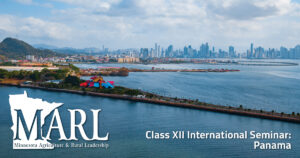 “The road of life twists and turns and no two directions are ever the same. Yet our lessons come from the journey, not the destination.” Don Williams, Jr.
“The road of life twists and turns and no two directions are ever the same. Yet our lessons come from the journey, not the destination.” Don Williams, Jr.
Class XII’s first full day on our International seminar in Panama kicked off at the Radisson Hotel in Panama City, beginning with a self reflection exercise to ensure that we can embrace the experience and be fully present. Toby then led our class through a learning exercise called Barnga, a Euchre-like card game where each group playing has a different set of rules and no communication is allowed, as a way to help us appreicate the challenges of navigating new cultural experiences without the benefit of perfect verbal communication. This helped us truly understand the importance of cultural adaptability, acceptance, and most importantly, empathy as we embark on this journey.
The learning continued during the morning, as we met with Peter Olson, attache for the USDA Foreign Ag Service. Peter walked us through the USDA’s role in country, focused on US market promotion, market access for US commodities, local market intelligence for US Companies, and capacity building. Peter was followed by the Regional Director for the US Grains Council in Latin America – Marshall’s own Marri Tejada-Carrow! Marri walked us through her team’s responsibilities focused on Developing Markets, Enabling Trade, and Improving Lives within her scope of responsibility for US Corn, Barley, and Sorghum exports. Interestingly, Marri shared that agriculture in Panama makes up only a small portion of the total Panamanian economy, relying on imports to feed and power (via ethanol) the population. Unsurprisingly, the Panamanian economy is driven in large part by the presence of the Canal, which the class will tour in detail tomorrow. Two demonstrations of leadership that Marri shared in her comments:
- Understanding cultural norms in communication is critical to building powerful and long-lasting relationships; the traditional American approach to daily work is not necessarily shared by the locals!
- Leadership in a country where you are the guest does not look like railroading your own agenda through the local political machine – and this can sometimes take patience measured in years, not months, for the perfect opportunity to introduce new ideas.
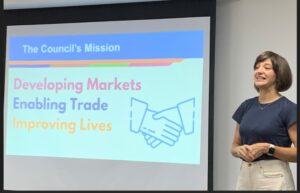
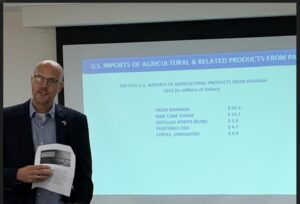 U.S. Grains Council, Latin America Regional Director – Marri Tejada-Carrow, Panama and native Marshall, MN native and Foreign Agricultural Service (FAS) – Peter Olson, Agricultural Attache, U.S.D.A. – provided orientation on import, export and agricultural product status in and out of Panama and global regions of Latin America.
U.S. Grains Council, Latin America Regional Director – Marri Tejada-Carrow, Panama and native Marshall, MN native and Foreign Agricultural Service (FAS) – Peter Olson, Agricultural Attache, U.S.D.A. – provided orientation on import, export and agricultural product status in and out of Panama and global regions of Latin America.
Following our morning of learning, we boarded our new “bus home” for the next 10 days, led by our tour guide Jorge, for lunch at a local restaurant. The fresh fish was FANTASTIC! MARL XII then got a group photo at the famous, multi-colored PANAMA sign. Jorge informed us that we were lucky – if a cruise ship was in the area, this simple exercise could’ve taken an hour or more.
After lunch, we split into separate groups to experience either the Smithsonian Institution on Wildlife in Panama or a local museum celebrating regional biodiversity. Whether seeing sloths lounging in trees, frogs in varying states of “compromising positions,” or appreciating the local fauna, we were all exhausted by the time we got back to the hotel for a respite before the evening activity: a traditional Panamanian meal and dinner show filled with music and dancing, with some “audience participation” (thanks for showcasing your skills David, Kelly, Toby, Renee, and Turkey Jake).
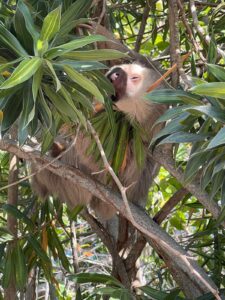
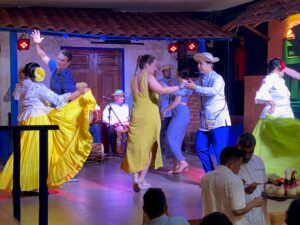 From unplanned (and possibly staged) MARL “engagement” photos (old friends Kevin and Sagan), to iguanas dropping out of the sky onto Kate, to breaking back into our own bus at the end of the evening (thanks for volunteering to get yourself through that tiny window, Corey – and this is a story worth asking your MARL Class XII colleague about IN PERSON), Day 1 concludes with all of us tired, our cups full, and hope that the rest of the trip can live up to Day 1!
From unplanned (and possibly staged) MARL “engagement” photos (old friends Kevin and Sagan), to iguanas dropping out of the sky onto Kate, to breaking back into our own bus at the end of the evening (thanks for volunteering to get yourself through that tiny window, Corey – and this is a story worth asking your MARL Class XII colleague about IN PERSON), Day 1 concludes with all of us tired, our cups full, and hope that the rest of the trip can live up to Day 1!
Corey “Our Hero” entering bus with help from class members to get all of us access thru an “open door!” Daily summary wrap up by Jason Robinson. MARL Class XII
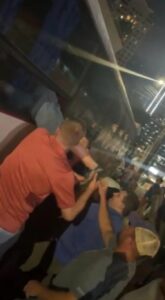 Tomorrow we will be on the Canal…. return for more drama and lessons from the Isthmus of Panama.
Tomorrow we will be on the Canal…. return for more drama and lessons from the Isthmus of Panama.
DAY #3 from Panama
Today was an awesome day. The first stop…Panama Canal. We were able to see the last ship of the day entering the canal at approximate 8:30 a.m. EST. Panama is experiencing a drought and 3 steps have been taken by the Panama Canal authorities to conserve water.
- Only half of the ships are being allowed through the canal.
- Large ships will often times have one or two small boats go through at the same time – referred to as “tandem lifting.”
- Water is transferred between chambers (locks) as much as possible – reducing water consumption by 50% per lift.
Ships travel from the Pacific to the Caribbean in the morning and vice versa in the afternoon. The water level in the locks is raised or lowered to move the ship through the canal, all water is fresh and moved without any pumps, there are many channels for directing water for each lift of a vessel.
The original (ancient) canal was finished in 1914. The first ship to travel the length of the canal was on the same day as WWI broke out. A new canal was built near Panama City in 2007 to keep up with the shipping demand. The toughest part of building a new canal was the logistics. There were 35 different countries that participated in the building of the new canal. For example the new lock doors were built in Italy and had to be shipped to Panama.
Locomotives are hooked to the ships with steering cables to keep the vessel from hitting the walls. We observed a ship proceed through the Mira Flores Locks today with about 12 inches of clearance on the left and the right side of the vessel and the lock concrete walls. The lock doors are now operated by computers, previously they were operated by human powered levers. There are no water pumps on the Panama Canal – everything is operated by gravity. Each vessel moving through the locks has assistance from locomotives “Mules” (cause in many canal systems – a mule “they animal” was providing power to move cargo on boats thru the water.
Before a ship enters the first lock a Panama Canal Pilot is taken to the ship to steer the vessel through the locks. The crew remains on board and follows the pilots direction.
The Panama Canal is one of the most well-known places in the world. A popular stop on the lake were islands that are home to monkeys. Yes, the monkeys on the islands are pleased with the popularity of the region. The one below is a Howler monkey – did you know that they are the loudest terrestrial animals in the western hemisphere. Born with blond fur, males turn black as they mature. Can you determine the gender of this one we spotted?
After our canal visit and the IMAX movie narrated by Morgan Freemen, we ventured to Lake Gatun. We got into small boats and were given a tour of Lake Gatun. Many large ships passed by us. Lake Gatun is man-made and was created by damming up the Chargas River. There are still 7 native tribes in Panama that are keepers of the land. They are self-governing and protect the rain forests.
Nancy Miller – contributing blogger – MARL Class XII
Chagres River in Panama revealed to us many secrets this afternoon. The source of much fresh water for the Panama Canal system
MARL class, after their adventures at the Panama Canal and a quick lunch, headed to “Old Town” Panama where we were able to experience the history and culture of historic Panama. MARL class experienced a variety of churches, shops, restaurants, and businesses.
A tour of the community garden and old town from Tino was next. His efforts allow area children the ability to partake in a community garden. This reaches far beyond the community garden as he is able to help provide the children with meals and other basic necessities.
MARL class wrapped up their evening with a meal together at Costa Blanca. Tomorrow MARL Class will head to Penonome to a pineapple farm and an egg farm! The adventure continues!
Ali Bouta – contributing blogger – MARL Class XII
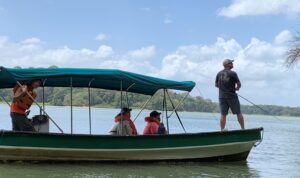 Catch you tomorrow… A good day fishing on the Chagres for MARL today!
Catch you tomorrow… A good day fishing on the Chagres for MARL today!
Day #4 – Departing from Panama City – – –
From Traffic Standstill to Agricultural Marvels –
Last night’s view – pretty cosmopolitan city.
Day four of our Panamanian adventure didn’t follow the anticipated script, initiating with a slow traverse through a 2-hour traffic standstill due to a protest. Our guide, Jorge, suggested the protestors might be retired police officers advocating for increased pension checks. Despite the delay, as we finally hit the road, our journey transformed into a captivating exploration of Panama’s infrastructure and agricultural wonders. The day’s pinnacle was witnessing the construction of a multi-billion-dollar metro train system designed ingeniously to traverse both above ground and under the canal. This showcased a substantial investment in the country’s transportation future, an ambitious move given the apparent need for observed road repairs during our journey.
Difficulty leaving town the morning… Protesting in the streets – stopped traffic – sat for two plus hours – in traffic, appreciated air conditioning…
AgroTourism:
Our initial destination was the expansive pineapple plantation, covering an impressive 400 hectares. This wasn’t merely a pineapple haven; it unfolded as a thriving ecosystem featuring an array of crops, including limes, passion fruits, mangoes, cassava, mandarins, and various other edible fruits. What set this place apart was the harmonious coexistence of cultivation and wildlife, with hills and small lakes enhancing the landscape. As we explored the plantation, our fascination extended beyond rows of pineapples to the vibrant display of flowers and tropical plants. Heliconia, bougainvillea, hibiscus, and other exotic plants, typically found as interior decor in the Midwest of the United States, thrived in their natural habitat. Amidst this diversity, a noteworthy addition was a restaurant on the plantation where we savored traditional dishes. The menu featured fried rice with chicken and raisins and chicken, accompanied by freshly squeezed pineapple juice.
MARL is blooming in many unique ways during the International Seminar… Scott Schoper displays the Bird Flower and Katie Covino additional color, shape and texture.
On to the Pineapple education and tasting opportunity…
Through the farms we explored, an abundance of crops unfolded. In the first plantation, we encountered a diverse array:
– Cassava (Caribbean Yuca): Regenerating from a stick, cassava thrives in the fertile Panamanian soil. It is described as tasting like a potato, adding a local flair to Panamanian cuisine.
– Dragon Fruit Cactus (Pitaya): Set to bloom in April, these cacti added a unique touch to the plantation.
– Limes, Mandarins, Soursop: Each fruit boasts distinct flavors and economic value. The Noriegas lime variety, with its edible bumpy skin, added a local touch.
– Passion Fruit Vines: Vineyard-like in appearance, showcasing the natural beauty of Panama’s flora.
– Coffee Trees: Yielding robust and bitter beans, ideal for a strong espresso or americano.
– Square Plantains: A staple in many Panamanian dishes, occupying a central place in the plantation.
Our journey also introduced us to local wildlife, from sloths to Caymans in the water and turtles. The diverse flora, featuring Heliconia with its chocolate-like scent, vividly portrayed Panama’s rich biodiversity.
Pollo Agricultura – Chicken or the Egg…
Our journey continued to a poultry farm, providing captivating insights into poultry and agriculture. The visit to a certified salmonella-free farm emphasized cleanliness and egg safety, with Respeggct.com shedding light on their commitment to eliminating chick culling. The farm’s efficiency was evident as it incubated an impressive 9600 eggs that morning.
Upon returning to our hotel, we indulged in traditional Panamanian chicken and beef empanadas before exploring local stores and a grocery, comparing prices, and discovering new flavors.
Day four, despite its slow start, transformed into an enriching experience, offering a glimpse into the intersection of infrastructure development and sustainable agriculture in this vibrant Central American country. Furthermore, what stood out during our agricultural exploration in Panama was the growing trend of incorporating agrotourism methods into farming practices. Farmers are diversifying income streams, aiming for sustainability during slower seasons. The pineapple plantation we initially visited, spanning an impressive 400 hectares, boasted its own hills and small lakes where cultivation and wildlife coexist harmoniously.
Contributing bloggers today – Kristy Mach, Nathan Hanel, Maria Kalyvaki, Scott Schoper & Kevin Kruize
“Knowing yourself is the beginning of all wisdom” – Aristotle
MARL cohort is working on self-awareness, self reflection and self-regulation.
Day #5 in the heart of Panama
In case you were wondering, the roosters in Panama say, “coocoodacoo,” baby chicks say “pillo pillo,” and the phrases “chick magnet” and “a good egg” don’t translate.” (I was told that you could complement a man on his good eggs, but only if you’re intimate with him.)
Panama day 5 began at Finca Don Lapo, a diversified farm that primarily produces eggs but also has a variety of livestock for agritourism. Rafael, the second generation farmer at Huevos Don Lapo, showed us two of the layer barns. Each flock of Isa Browns spends 16 weeks in a brooder barn before moving to the next building, where their 18,000 eggs are collected by hand three times a day. Most are sold through a combination of resale and direct sales, both locally and in Panama City.
The farm uses spent rice hulls for bedding and hand blends its own feed, mostly a corn and soybean mix that comes from the United States. Calia, the farm manager, explained that the ration also includes vitamins to help with yolk color and achieve better egg quality.
After many standard attempts at rodent control failed, Rafael says that the farm has had success managing them with snakes (!). He assured us that their diet is rich enough in mouse protein to keep them away from the eggs and chickens. None of the MARL members seemed keen on trying this out at home.
Avian flu is less of a concern in Panama, possibly due to the hot and sunny climate. This is fortunate, as Rafael anticipated that there would likely be no government assistance available in the event of an outbreak. Still, the farm practices biosecurity and treats their flock with some antibiotics to safeguard against intestinal viruses.
Aside from livestock production, One of the most relatable topics Rafael discussed with us was the challenge of multigenerational farm succession. He and his siblings were encouraged to get an education and study abroad, which certainly provided them opportunities but may have kept many from returning to the business. He said he is always looking for ways to attract more of his family (immediate and extended) back to the business. Agritourism is one way they are trying to diversify (the farm has a variety of birds, unique poultry, cows, sheep, iguanas, rabbits, and deer), and Rafael continues to try modernizing their operation using computer technology.
Our chickens might sing different songs, but our farmers have many of the same dreams and challenges!
Friday afternoon we made our way to an agriculture school where students can enroll starting at age 14. They can receive their high school certification in 3 years or continue on to receive technical training for 5 years. Students are able to live at the school and for a fee of $60/month this includes room and board. This allows students from all over Panama to enroll in the school. Currently, 176 students are enrolled. To become a student, they have a 2 week “bootcamp” period to make sure the students know they want to have a career in agriculture. They must know how to use a machete and basic skills like how to drive a tractor. This period weeds out the students who do not want to be there. While the school is currently run by the government, they are in the process of transitioning into a more private school so all the funds from sale of products produced on the farm can go back to the school. Students have the opportunity to learn skills from dairy farming, goat farming (milk goats), pigs, beef and many crops.
Once the school transitions to an independent school, the plan is to offer more technical training as well as traditional farming training to allow students to understand they do not need to have lots of land to have animals or crops available to feed their own families. The more technical training can allow students to be more employable in larger sections of agriculture. As a previous high school agricultural educator, it was great to see opportunities for young people to learn skills in a hands on setting and the similarities as well as differences between US and Panama.
Contributions today by Sue Gorman & Katie Covino
The heat was intense here today. The setting sun on the beach was delightful…
Share more with you on the weekend… MARL International Seminar continues….
Day #6 – Saturday…
Buenos Dias. We awoke the morning of Day 6 to the soothing sounds of the Pacific on Las Lajas beach and enjoyed our breakfast al fresco with views of the crashing waves.
After breakfast we met Lisa DeeGracia, our local tour guide who will be with us the next few days as we are in the region. Lisa is an expat from the Netherlands who quit her Amsterdam job in finance to live the simpler life in Central America and after meeting a local vaquero (cowboy), she settled in Las Lajas and has found a passion with sharing the true Panama with others. We learned that Las Lajas beach has long been a favorite of the locals where they would come to make salt from the ocean while enjoying a working vacation; it is still very popular during school holidays and Carnival.
We made our way through the costal flats filled with pastures, cows, and mounted vaqueros to our first stop. Hermanos Motta’s is the largest farming operation in Panama started by 5 brothers and now being run by the third generation. The family is one of the wealthiest in Panama and now have business ventures in many industries including air travel and liquor distribution.
We experienced three parts of their farming operation: show cattle, rice processing, and a palm oil plantation. Senor Francisco, the general manager of the farm, has been working for Hermanos Motta’s for seven years prior to which he worked in the Banana industry. He shared about their prize winning show cattle which have won dozens of championships in Panama and Central America. The farm breeds Brahman cattle which are selected for their heat tolerance, temperament, beef and dairy production. The farm uses artificial insemination and embryo transfer to select for premier show cattle and embryo from one of their cows can sell for $7,000. Some of our classmates experienced in show cattle got to lead the cows and put their showmanship skills on display.
The next operation we experienced was their rice mill. Senor Israel, the rice mill manager, lead us through the mill that processes the rice from the Hermanos Motta’s farm as well as smaller local farms for a total of 700 hectares worth of rice. The rice is hulled and processed into both brown rice and white rice and distributed around the country of Panama. The broken rice that is not desirable for human consumption (about 12%) is transferred next door to the farm’s feed mill where it is mixed with corn, soy, wheat, and other minerals by the farm’s nutritionist to be used in their cattle operation. Even the rice hulls are used to heat the rice dryer so nothing goes to waste.
Our last stop on the Hermanos Motta’s farm was the palm oil planation. Senor Carlito and his work crew showed us around the 60 hectare grove of palm trees. The fruit of the African Palm tree is the most productive oil crop grown in the world; with 160 trees per hectare, palm trees produce 25 tonnes of fruit per hectare in a year. The fruit looks like a large pinecone shaped object of red berries that weighs about 35lbs. These fruit are cut out of the tree tops with long poles and shipped by truck to a processer. Rick got to try his hand at the harvest and successfully brought a large fruit crashing to the ground. After initial planting, the grove becomes productive after three years and will continue to produce for 30 years before being razed and replanted. The biggest pests they fight are fungal infection and a beetle that will burrow into the tree and kill it outright.
After a much needed lunch break at a local Italian owned pizzeria, we explored the village supermarket to compare prices of common household goods in Panama to those back home in Minnesota. Although many items were similarly priced to the U.S., when taking into account the lower average earning of Panamanians, household goods take a significantly larger portion of the income here in Panama.
Our last visit of the day was at the Carrera Cattle farm, a medium sized operation with around 1400 head of cattle on 1000 hectares of grassland. Jorge, a mounted vaquero, picturesquely drove a herd of 250 cattle across the pasture for our viewing pleasure. These cattle were mostly Brahman, but with some Simbra genetics running through the herd. We were surprised to learn the male cattle are left as bulls for their entire life unlike the steers we are used to dealing with at home. These cattle take about 18 months on pasture before they are sold for beef at about 1200 lbs. Jorge loved asking us questions about how we raise beef cattle in the Midwest and was surprise to learn none of us knew how to use a lasso. He even let a few of the horsemen in the class ride his horse around the pasture.
By midafternoon, hot and exhausted would be an understatement to describe our condition. We eagerly hit either the ocean or the pool to cool off after returning to the resort. The beauty of the Pacific, especially the sunset, continue to amaze us as we enjoyed each other’s company around dinner and a relaxing evening.
Tomorrow we look forward to visiting an indigenous village and learning about the traditional agriculture practiced there.
MARL Class contributing blogger – Megan Horsager
2/25/24 – Day #7
Jason Robinson – Kevin Kruize – blogging Team for MARL Class XII
Village: Guabo – Tribe: Ngöbe Bugle
Today our group visited the indigenous village of Guabo, home to a Ngöbe Bugle family tribe. After a beautiful (but hot) forest trek of about 0.5 miles, we arrived to greet the village chief Marciano and his wife Ofelia Ruiz relaxing in a hammock.
Marciano, in Spanish, told us that he attended a Baptist church last night and is not working today, nor is he attending the baptism ceremony happening today in the local river so he can greet us. Marciano and his wife Ophelia have been baptized Baptist, and felt that Baptist is the truest to his traditional belief system, despite other religious systems brought by missionaries to the region. Our classmate Katie Covino was the star today, spearheading a conversation in Spanish with Marciano ranging in topics from what we grow in Minnesota to religion and marriage (as an aside, Marciano and his wife have been together for 45 years, married when he was 25 and she was 15).
After spending time with Marciano, we visited the village shop to purchase some of the village women’s goods (including purses/bags, beaded jewelry, and dresses). Lucretia, one of the village women, demonstrated how they created their goods – stripping fibers from pita leaves, dyeing them, and weaving them together to create the chakra (purse). On their village sewing machine, another village woman, Elvia, demonstrated how she creates the women’s brightly colored dresses on a manually-powered Singer sewing machine.
Lunch was then served to us by the village women – rice and local produce (yucca, yucca root, guanpoo beans, and yampi) cooked over a wood fire and served on a bigao (“bee-how”) leaves.
The trek in and the return hike was up and down, across water and allowed us the opportunity to bridge more than the water. Many bridges are presented in life – deciding where and how to journey on the path is what we are encountering here in Panama.
Evening at the Las Lajas Resort was all Panamanian. Sipping from freshly harvested coconuts – gathered by Gamma and sliced with a significant machette!
Last sunset for this Class in Panama on the Pacific.
Sunrise will greet us again tomorrow – the good Lord willing…
2/25/24, Day # 8 – Monday
Our first stop of the morning was a a dairy farm owned by the Motta Hermonos. We started with a tour of the parlor. Their dairy farm was milking cows in a double 11 herringbone parlor. They were milking 300 cows – (Gyr X Holstein crossbred animals) two times per day milking. After walking through the parlor we met with the herdsman/manager of the facility – his name is Hermano. He shared with our class the calf care protocols and answered many questions.
When he was asked to share about a significant accomplishment under his leadership at the farm, he replied with the challenge of taking on an existing dairy that was averaging a herd of cows with a somatic cell count (scc) of 600,000. There were production and personnel issues. Today the dairy is averaging under 200,000 scc and 20-30 liters per cow rolling herd average. This resulted from a) training workers, b) sound communication, c) teamwork, all in an effort to make dramatic improvements.
. The tour of this Las Lajas region dairy operation was impressively clean and resembled a dairy farm in back home in Minnesota. We were on the road again, following a message of gratitude shared by Lisa, native born Hollander, married to Gama, native of Panama – they were our hosts on the Pacific Ocean and provided a rich experience at there resort and sharing of Panamanian culture. METO! METO!
The second stop of the day was in Boquete, at the Don Pepe Estate Coffee, established in 1898. This coffee plantation was located in the mountains, where all coffee is grown. In cool, shaded mountainous areas. Our tour guide was Carlos, a multi-lingual guide, speaking German, English, French and Spanish. Carlos had over 30 years experience in the coffee industry. Starting as a coffee bean picker at 10 years of age, advancing to team leader, roaster and sorter of coffee beans.
Following a work related industry, please know that the coffee beans are packaged in 60 kg. coffee sacks (that is 132 pounds) – Carlos experience a back injury and decided to pursue a position as a tour guide. He impressed us with his knowledge of the coffee business in Panama where they produce “arrabica coffee beans.” These beans are best suited for the climate in the region at an elevation in the mountains with rich volcanic soil, higher altitudes and plenty of rainfall. They produce a coffee bean that is a mild – bitter bean.
. Panama coffee growers are truly independent with the ability to produce whatever variety they choose and may sell their production to whomever they desire. Unlike other Latin American and Caribbean countries where government dictates coffee production decisions.
Right now in Panama, gentrification is an issue that coffee producers are facing. Lands that coffee is traditionally grown on are being purchased by over-seas developers who are building mountain estates. This inflation of land values is pushing Panamanian people from their home territories.
Following our coffee farm tour, we were guided to the drying and processing area of the business, drying can be done outside in long elevated tables with screen bottoms and the beans are spread thinly on the drying structures which were approximately 50 meters long and covered with plastic at the end of each day or when raining. The procedures for drying can also be either on a dray concrete slab on sunny days and then accelerated with artificial drying. We witnessed the drying of coffee beans in air dryers fueled by coffee husks – for a low heat drying process. Their goal was to store beans at 12 percent moisture for a six month period for aging prior to roasting them at the estate or for sale on the world coffee market.
The final phase of the tour allowed us the privilege of tasting coffee. There were 6 different varieties that we were able to taste, all produced at Don Pepe Estate. We savored the aromas, flavors and after taste of each blend and were guided with in depth instructions on slurping… by Carlos. The tour ended with MARL class members making purchases of favorite coffees and Estate gifts.
Our third visit of the day was a few kilometers down the mountain at the Pepper King Farms, Inc, a second generation family business producing peppers, lettuce and onions.
We were greeted by Humberto-son, sister –Amarilous, and their Father. This operation was positioned on the hills above Boquete, Chiriqui, and produced Romaine lettuce, green, red and yellow bell peppers and more recently onions.
All production was in greenhouse environments. Humberto took us on a tour of the green houses. He described cultural practices used to produce fresh, sustainable, high quality and high yielding produce. We were provided a visit to the production area, seeding, growing, discussing growing from seedlings, transplanting, soil preparation, irrigation, crop protection and harvesting, processing and packaging.
They, son, daughter and their father discussed with us the demands of their farming operations and the benefits along with challenges of supplying nationally fresh produce to super market stores across the country. PriceMart is their number one buyer of their products. After the tour of the greenhouses our group was invited to share many questions, discussion about culture and language. Humberto was quite proficient in providing our tour of the farm and packaging areas in English.
During the time shared at the farm, his father – who was educated in boarding school in New Jersey from middle school through high school and college was challenging the next generation to be multilingual and successful business owners. We did discuss farm business transitioning struggles, business diversification and finding quality labor to produce quality products. Although we were many miles from home, our MARL delegation was able to relate to their business challenges and successes. We all had the opportunity to enjoy some Pepper Queen Jelly, with crackers and cream cheese – this provided additional time for conversations, cultural awareness and sharing.
A good opportunity to learn and grow. We appreciated all the tours and Pepper King Farms was a finale for the day in Boquete.
Hey, the class is looking forward to a day of relaxation and recreation in the Chiriqui region of Panama! Check in for more to come. Adios….
MARL Seminar Management blogging team: Ali Bouta, Corey Cervin, David Beyerl, Nancy Miller and Cody Suter.
2/27/24 – Day# 9 – Relax, Recreation, Rest in Boquete
Boquete the Beautiful
MARL Class XII after many days of traveling through the amazing country of Panama was able to enjoy some free time to relax and take in what the beautiful city Boquete has to offer.
Boquete is located in a mountainous region of Panama (elevation is 3,900 feet) and is voted as one of the top retirement places in the world!
Valcan Baru is the largest mountain at 11,400 feet and is also an active volcano, which we have amazing views of all through the city! This region has many fun adventures from white water rafting, zip line courses, gorgeaous golf courses, fishing and many hiking adventures amongst others activities.
Several of group members enjoyed the Lucero Golf and Country Club. The course had amazing views nestled in the mountains where the group may have contributed a couple of golf balls to the challenging course!
A few members enjoyed the pool and gorgeous views the country club had to offer.
With miles of ziplines available, a couple brave souls took on the challenge and flew through the sky of Boquete. They enjoyed a quick lunch on top of a mountain and zipped through 8 courses through the trees.
Hiking trails are scattered throughout the area with great opportunities for stunning views and waterfalls! You can pick from guided tours or find a trail to explore on your own. Almost half the group went hiking on some very challenging steep rocky and wet trails in the dense cloud forest jungle. Although no monkeys or other animals were spotted, three spectacular waterfalls were part of the experience and the sound from the splashing water hitting the rocks was mesmerizing. On a clear day, one is able to see the ocean from some of the open areas.
Panama is famous for its world class fishing! Panama also means “an abundance of fish” and at least one of us had to test our skills in deep sea fishing. An hour and a half trip to the Pacific Ocean was nothing to hold Rick Swenson back from an opportunity to catch a trophy. He was picked up at the hotel at 5:30am and returned 13 hours later. Kindness does abound and the catch of the day was a hit!
Some of the group just took a relaxing day to rest, catch up on emails and enjoy the small town shops, church visits and restaurants.
We will experience the serenity and vast amounts of agriculture in Boquete for one more day before starting to prepare for heading back home.
Blog Contributors: Kevin Kruize and Nathan Hanel
A blessing to learn, share, rest, recreate, nourish and share in Boquete!
2/28/24 – Day #10 Wrap Up MARL Class XII International Seminar:
MARL class XII embarked on day 10 of our international travel seminar today in Boquete, Panama. After breakfast, we loaded the bus to relocate to the Cental Park of the city for instruction of the MARL version of the Amazing Race. The class was broke down into groups of 2 or 3, each of which would need to gather information on various aspects of life in Boquete. Groups were asked to complete various tasks such as negotiating with local vendors, communicating with the police, analyzing the real estate market and exploring areas of local life.
We all needed to use our cultural intelligence to successfully navigate within the community and learn about a specific element of the culture/community to complete the task. Cultural intelligence is the “capability to function effectively across national, ethnic, and organizational cultures” according to the book “Conceptualization of Cultural Intelligence.”
Groups observed and communicated with people of the community about the police force, fashion, businesses, markets and property to name a few.
Communication in a different language presents challenges and opportunities. Spoken words, hand gestures, body language and pictures can all support communication. A smile can be shared in any language.
After lunch on our own with partner/s we gathered to reflect on our findings with the entire group at our hotel. We were able to share what we learned and took the opportunity to learn from each other. Reflections clarify, provide revelations, enable learning and expand awareness.
Each group was challenged with a question comparing the culture/people/things they saw to assumptions one might have about that particular observation. For example, My partner and I were challenged to ponder if we disagree or agree with the statement “when I come in contact with people from a different culture, I can find I can change my behavior to adapt to theirs.” The reflection of the activity allowed us to take all our experiences in Panama to evaluate our assumptions, focus on what we learned, our takeaways and how we will use what we learned for future cross-cultural situations.
From this activity we once again loaded the bus for David to catch an evening flight across country back to Panama City in preparation for our departure tomorrow.
Traveling ten days with people you know and trust on a bus presents a unique set of conversations, shared experiences and some nap time.
Across the country of Panama we were fortunate to have a skilled and professional driver – owner & operator of the bus! Dario is a Panamanian from the town of Penonome. We appreciated his contributions on our travels.
2/29/2024 – Day #11 – Return home from Panama City
Early to the airport, getting tickets, seat assignments, checking baggage, TSA check, navigating the travel scene.
Reflections: Class Members shared:
The experience exceeded my expectations. I have built strong relationships with more people and very grateful for the opportunity.
Absolutely loved everyday, make sure to keep the variety of tours and different experiences, everything worked well for me.
What I will take away from this international seminar – I need more patience with cross cultural opportunities and watch body language.
I enjoyed listening to how others interpreted various events and experiences and comparing to how I saw or interpreted things. Loved experiencing the culture and changing my mindset about how I travel to another country. Open my eyes to what is happening around me and be more aware of opportunities to learn.
Great places we visited – farms/hotels… learned a lot!
What I will take away from this experience – The power of shared experiences to create deep and meaningful connections. The people we met along the way made the journey worth it!
Take away? It was fun to see the progressive farmers be interested in what we have going on in Minnesota. Great location, accomodations were very nice.
Take away? Friendships, connections and experiences!
What worked well for you? Really, most things worked well… I especially enjoyed the Panama Canal visit, the Old Town visit, Coffee Plantation and Greenhouse Production facility tours.
What I will take away from this seminar? – It will be valuable to share my experiences with others. Boquete was Beautiful!
Take away? Seeing things through a different lens. We’ve been able to see how people in Panama live, which in some cases is very different than my personal experiences. Being able to see that and learn from others is crucial. It will be a memorable experience that will last a lifetime.
Take away? Just because they look like me doesn’t mean they think or talk like me. Just because they don’t look like me doesn’t mean they don’t think like me.
Take away? Humbled and grateful/blessed for everything I have at home. Various leadership tips: Communication, organization and discipline is vital to success.
This was a once in a lifetime experience. I am glad I participated as much as I did. Another great seminar!
Take away? The culture – the American influence. What would I like to see changed? Better education for the people of Panama.
Impression: The most important perspective was seeing the indigenous village and how they live.
General comment: Food and lodging was far above my expectations. I have a better understanding of the challenges in a global food economy.
What worked well for me? Understanding a slower pace and adopting it sooner than usual.
We know that the ships will come and go from the Isthmus everyday. As one can see from the aircraft window, while we flew from David to Panama City – they vessels were positioning for the next morning passage through the canal locks. As people leading and working in agriculture we also position ourselves. It is important to have a support system to guide us, be supported by people that are trustworthy and kind. We do not always know that path or channel where we will be traveling. If one does keep an open mind, with a thirst for learning and by taking care of others with a sense of gratitude. . . the journey can be rewarding and fulfilling.
A rewarding experience for all 25 persons on the Panama MARL International Experience. METO! in Spanish means “wow!” This seminar to Panama was meto!
Thanks to the MARL sponsors “investing in people” and supporting this among many experiences.
We are grateful.
As was stated in the beginning of this blog. “Yet our lessons come from the journey, not the destination.” Don Williams, Jr.
We started our day with lunch at Lakeside Event Center and Golf Club in Perham.
Doug Huebsch, MARL Class IV Alumni, Perham native and current resident who is very active in the community shared welcoming message and highlights of his MARL Class experiences. His life experiences have led him down four paths: Agriculture, Real Estate, Retail and Service. Doug has operated a turkey farm and a cow-calf beef operation. He has and does own real estate as part of an investor group in Perham that has provided housing for the community. He is also an investor in a number of local retail businesses in Perham and in the New London/Willmar areas. Lastly, he is very service oriented serving 12 years as a Ottertail County Commissioner and as current Vice Chair of the University of Minnesota Board of Regents. Doug presented an overview of the Perham community, highlighting the importance of creating and maintaining an attractive location amidst the Lake Region for people to live, work and engage in recreation. The Perham Area Community Center, Boys & Girls Club, new school system and healthcare facilities were highlighted amongst the favorable business environment that the City of Perham and County has supported.
Following the Highlights of Perham as a community MARL Class XII began work focused on Facilitating to LEAD. Throughout this part of the seminar we talked about what it means to lead and facilitate as well as what followership is. We identified different leadership mindsets and how they worked to facilitate meetings and committees. We worked individually as well as in small groups to understand the importance of each of these roles. We identified skills and tools that both facilitators and followers could use to have successful meetings. Specifically we talked about 7 common traps that derail a productive meeting.
7 Common Traps: allowing productive meetings to derail…
Trap 1: Letting Private Interests Influence Public Decisions
Trap 2: Lacking Direction and Purpose
Trap 3: Filling Seats with the Usual Suspects
Trap 4: Going “Off Track”
Trap 5: Making Decisions Outside of Meetings
Trap 6: Getting Stuck in Conflict
Trap 7: Lost in Virtual Space
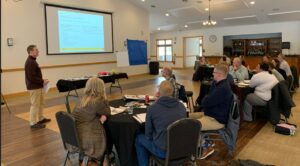
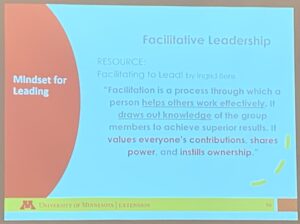
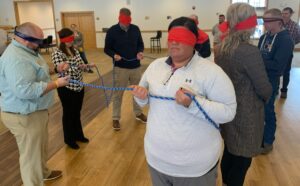 After this workshop, we were able to spend time in the evening at the Disgruntled Brewery, which Doug owns in Perham and network with the MARL Class, Alumni and some community guests. Grateful for place to be nourished and network – Thanks Doug, Becca and crew at the establishment – good time had by all. Enjoyed the tour and photo opportunity.
After this workshop, we were able to spend time in the evening at the Disgruntled Brewery, which Doug owns in Perham and network with the MARL Class, Alumni and some community guests. Grateful for place to be nourished and network – Thanks Doug, Becca and crew at the establishment – good time had by all. Enjoyed the tour and photo opportunity.
Thursday-January 25th
Thursday morning MARL Class XII kicked off our day with a tour of Bongards Creameries – Perham Plant. Plant Manager Justin Larson took us through the facility where 4.2 million pounds of milk are processed daily. A current expansion to be completed in the spring of 2025, will increase that amount to 5.5 million pounds a day. Bongards has been a co-op since 1908, specializing in cheese making in addition to butter and whey production. Bongards of Perham serves around 250 dairy farmers in a 150 miles radius of the plant. As a manager for over 9 years, and a family history with managing Bongards, Justin was extremely knowledgeable and truly had a passion for cheese production. Justin expressed how much he enjoyed the co-op structure and how it allowed himself, employees, and board members to serve the patrons while producing a wholesome product.
Converting waste into power.
Brian Schmidt and Scott Mattson at Prairie Lakes Municipal Solid Waste Authority gave us an inside view of creation of energy from waste. This facility is a partnership between five counties to handle municipal solid waste and create steam power.
The process starts on the tipping floor, where trucks are unloading the waste from area counties focused on minimizing landfill accumulations. After the trucks are unloaded, the waste material is sent to the municipal utility reclaiming facility. This process sorts household waste, removes recyclable materials and PCB’s????
Once the material is prepped it is loaded into a burner, incinerated and the heat generated runs a boiler to produce steam. This steam is sold to industries needing the steam source – like Bongards’ Creameries and Tuffy’s Pet Foods, both Perham businesses working in collaboration with the solid waste authority.
According to David Beyerl, “the neatest part of the tour was seeing how they use 55,000 tons of garbage to create energy (STEAM) to process raw agricultural commodities into food” – pet food (Tuffy’s) and cheese at (Bongard’s Creameries.)
KLN Candies:
This afternoon we had the privilege to meet with folks at KLN Brans. Robb Moser and his team talked about their business and mostly about their “WHY.” KLN Brands is a very community focused organization. They are involved in many facets of Perham and beyond that truly give back and also support their employees to purchase a home as well as collaboration with the local hospital to increase local daycare options.
The President of the KLN Brands, Chase Rasmussen, spoke as well as highlighting the fact that KLN Brands does not just manufacture and sell ap product, they do that to give back. Again, he kept going back to the “WHY” of their business. Courtney Rooney also joined us. She is the company’s Dream Manager, with a background in mental health, she is working with employees to reach their life goals and dreams all as a way to create a great working environment at KLN.
We were treated to a great tour of the production floors of candy and popcorn and numerous snacks from their production lines were provided. Consistently we saw positive employee interaction amongst each other and with management. Great facilities, a growth mindset, and a giveback attitude were major take away points.
Our evening session was shared with MARL Alumni Carl Aakre, Class V, National Director of the Curriculum for Agricultural Science Education (CASE) a special project supporting middle school and high school Ag, Food & Natural Resources Education across the country. We appreciated learning with Carl and hearing his journey in leadership post MARL Program participation.
Friday-January 26th
On Friday, January 26, 2024 in Perham, MN the MARL Class XII met to introduce their Capstone projects to the MARL Shark Tank Executives. All Capstone projects presented were impressive. Helpful suggestions were shared with the presenters and many classmates had ideas and referrals to share. Without spoiling the presentation at graduation, some of the topics included:
- Working with the local FFA alumni program to expose FFA members to them many different jobs included ag.
- Being on the board of a new Agricultural Children’s Museum
- Expose students to the meat industry in order to maximize its growth.
- Working with local corn and soybean grower’s associations to increase activities and membership.
- Create a MARL mentorship program.
- Bring tools to Employer Farmers to stay compliant with state employment laws and the Department of Labor.
- Research and document resources for rural community’s EMS teams.
- Create an elite fleet of driver’s in the workplace.
- Restart/revamp the local FFA program.
- Expand the largest sugar beet competition display at the State Fair. Most importantly this will include educating the State Fair visitors.
- Work to create a tax incentive for farm landowners to rent their last to a beginning farmer.
- Work with youth to create excitement about ag opportunities.
- Create a social media plan around a Day in the Life of a Turkey Farmer.
- Work with family to create a value added product by using current buildings and farmland more efficiently.
- Create access to right sized manufacturing for cottage industries in rural communities.
Ali Bouta, Glenwood Nancy Miller, Kerkhoven
Cody Suter, Murdock Corey Cervin, Darwin David Beyerl, Murdock
The first speaker was Darren Newville, District Manager of SWCD and is a member of MARL Class IX. Darren grew up in Fairmont, MN and spent as much time as possible outdoors. His hobby is wildlife photography. He moved his family to Perham 13 years ago.
Darren’s office of SWCD has 80 grants from federal, state and local resources. One of their tasks is to work to manage water runoff with farmers that irrigate their farmland. Dan’s team will also work with farmers to conserve and protect resources. All SWCD programs are volunteer. They are a local unit of government and are political subdivisions of the State.
The second speaker was Nick Leonard, Deputy Administrator of Ottertail County. Nick grew up in NE Iowa where his parents were small business owners and his grandparents were rural leaders. Nick shared his 7 points of leadership:
- Be invested in community projects. Different people re invested in different ways.
- Rural leaders need to be generalists. They help whomever shows up on the doorstep.
- Have 3 value systems: personal, organizational and cultural. Know what your values are for all 3, they may conflict.
- Focus on most, not a few.
- Take responsibility when you make a mistake.
- Influence others by focusing on their needs.
- Meet people where they are at.
- Create trust – do what you say you are going to do.
There was a lot of work put into the Perham session by Brad, Toby and their staffs. All of that work lead to a successful session. Next stop: Panama!
Respectfully, Nancy Miller, Ali Bouta, Cody Suter, Corey Cervin, David Beyerl – Seminar Management Team
Please click on each hyperlink below to view the appropriate document:

